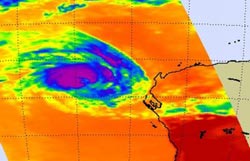
NASA sees strong thunderstorms still surround Cyclone Iggy's center

The Atmospheric Infrared Sounder Instrument called AIRS that flies aboard NASA's Aqua satellite captures infrared data and basically takes the temperature of cloud tops in tropical cyclones. That's a critical component of a tropical cyclone because the colder the cloud top, the stronger the uplift and energy in the storm.
The threshold that indicates strongest thunderstorms and highest cloud tops is -63 Fahrenheit (-52.7 Celsius) in AIRS data, and cloud tops around Iggy's center were colder than that. That means there is still a lot of strength in the storm. AIRS data also shows there are tight bands of thunderstorms that are wrapping into the center of the storm. Microwave data from NASA's Aqua satellite showed an eye in the storm, despite its status as a tropical storm.
On January 31 at 1500 UTC (10 a.m. EST) Tropical Cyclone Iggy's maximum sustained winds had decreased to 50 knots ~58 mph/~93 kph). It was located 330 nautical miles (380 miles/611 km) west-southwest of Learmonth, Australia, near 24.5 South latitude and 108.3 East longitude. It is moving to the south-southwest at 13 knots (15 mph/24 kph). The storm is just over 220 nautical miles (~253 miles/~407 km) in diameter.
Iggy has begun moving to the south-southwest, and is expected to curve back later southeast towards southwestern Australia. Current forecasts expect Iggy to weaken as it runs into strong wind shear and cooler waters. Iggy may dissipate before making landfall.












